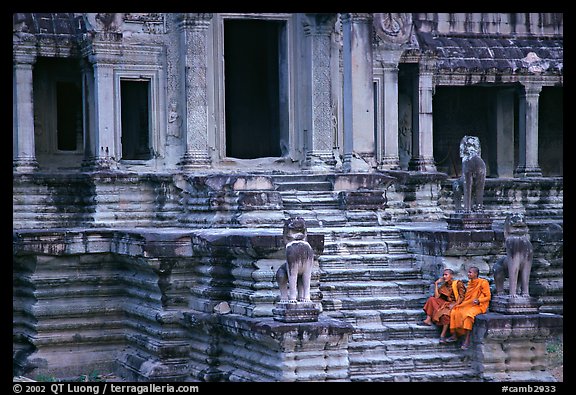



The Angkor Wat has become a symbol of Cambodia(or Kampuchea), and is a source of great pride for the country's people. A depiction of Angkor Wat has been a part of every Cambodian national flag, hence the only building to appear on any national flag.
In January 2003 riots erupted in Phnom Penh (Cambodia's capital) when a false rumour circulated that a Thai soap opera actress had claimed that Angkor Wat belonged to Thailand.Covering an area of about 81 hectares, the complex consists of five towers, which are presently shown on the Cambodian national flag. These towers are believed to represent the five peaks of Mount Meru, the Home of Gods and Center of the Hindu Universe. The modern name Angkor Wat means "City Temple" in Khmer, Cambodia's official language.
 <- the Cambodian national flag
<- the Cambodian national flagThe Temple of Angkor Wat was dedicated to the Hindu God Vishnu by King Suryavarman II, who reigned between AD 1131 and 1150. The Temple was constructed over a period of 30 years, and illustrates some of the most beautiful examples of Khmer and Hindu art. In the later centuries, it was converted into a Buddhist temple by latter day Khmer kings, who changed the state religion from Hinduism to Buddhism.
 Buddhist monks in the temple
Buddhist monks in the templeAn interesting story follows:
For hundreds of years, the lost city of Angkor was itself a legend, lost in time. Cambodian peasants living on the edge of the thick jungle around the Tonle Sap lake reported findings which puzzled the French colonialists who arrived in Indo-China in the 1860s. The peasants said they had found "temples built by gods or by giants". Their stories were casually dismissed as folktales by the pragmatic Europeans. Yet some did believe that there really was a lost city of a Cambodian empire which had once been powerful and wealthy, but had crumbled many years ago.
Henri Mahout's discovery of the Angkor temples in 1860 opened up this `lost city' to the world. The legend became fact and a stream of explorers, historians and archaeologists came to Angkor to explain the meaning of these vast buildings. Gradually, some of the mysteries were explained, the Sanskrit inscriptions deciphered and the history of Angkor slowly pieced together, mainly by French scholars in the late 19th and early 20th centuries.
Since the 1990s Angkor Wat has seen a resumption of conservation efforts and a massive increase in tourism, although most work is carried out by foreign government-sponsored teams rather than by the Cambodian authorities.
Antonio da Magdalena, a Portuguese monk who visited in 1586 and said it
is of such extraordinary construction that it is not possible to describe it with a pen, particularly since it is like no other building in the world. It has towers and decoration and all the refinements which the human genius can conceive of.

No comments:
Post a Comment